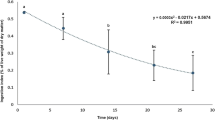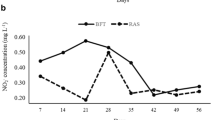Abstract
The effects of water exchange on growth and welfare of Nile tilapia (Oreochromis niloticus) were investigated in a recirculating aquaculture system during an 8-week trial. Fish of initial body mass of ~ 27 g (n = 8 per tank) were reared in 60-L tanks with water exchange rates, corresponding to 1.5 (LE), 3 (ME) and 6 (HE) tank volumes/h. Treatments were triplicated and fish were fed at 3% of their biomass each day. The LE treatment resulted in significantly higher (p < 0.05) levels of ammonia nitrogen and phosphate in the culture water relative to the higher water exchange treatments. The specific growth rate (SGR) of fish cultured under the HE treatment (2.74% day−1) was significantly higher than the SGR (2.21% day−1) of the LE fish. Mean final body weights of the LE, ME and HE fish were 97.67 ± 8.13, 110.50 ± 22.45 and 123.92 ± 10.00 g, respectively. Higher prevalence of dermal ulcerations, oral lesions and poor fin conditions were associated with the LE and ME fish. After 4 weeks, 34 and 24% of the LE and ME fish, respectively, had advanced mouth lesions compared to 0% for the HE fish. Haematological indicators of long-term oxygen stress and disease conditions, as evidenced by erythrocyte and platelet indices, were generally higher in fish under the LE and ME treatments. This study has shown that although the Nile tilapia is a hardy species, long-term exposure to poor water conditions can result in reduced growth and compromised welfare.
Similar content being viewed by others
References
Ashley PJ (2007) Fish welfare: current issues in aquaculture. Appl Anim Behav Sci 104:199–235
Atwood HL, Tomasso JR, Webb K, Gatlin DM III (2003) Low-temperature tolerance of Nile tilapia, Oreochromis niloticus: effects of environmental and dietary factors. Aquacult 34:241–251
Badiola M, Mendiola D, Bostock J (2012) Recirculating aquaculture systems (RAS) analysis: main issues on management and future challenges. Aquac Eng 51:26–35
Bosakowski T, Wagner E (1994) Assessment of fin erosion by comparison of relative fin length in hatchery and wild trout in Utah. Can J Fish Aquat Sci 51:636–641
Brett JR, Groves TDD (1979) Physiological energetics. In: Hoar WS, Randall DJ, Brett JR (eds) Fish physiology, vol 8. Academic press, London, pp 279–352
Buřič M, Bláhovec J, Kouřil J (2016) Feasibility of open recirculating system in temperate climate – a case study. Aquac Res 47:1156–1167
Caldwell CA, Hinshaw J (1994) Physiological and haematological responses in rainbow trout subjected to supplemental dissolved oxygen in fish culture. Aquacult 126:183–193
Coeurdacier J-L, Dutto G, Gasset E, Blancheton J-P (2011) Is total serum protein a good indicator for welfare in reared sea bass (Dicentrarchus labrax)? Aquat Living Resour 24:121–127
d’orbcastel ER, Blancheton JB, Belaud A (2009) Water quality and rainbow trout performance in a Danish model farm recirculating system: comparison with a flow through system. Aquac Eng 40:135–143
da Silva WF, Egami MI, Santos AA, Antoniazzi MM, Silva M, Gutierre RC, Paiva MJR (2011) Cytochemical, immunocytochemical and ultrastructural observations on leukocytes and thrombocytes of fat Snook (Centropomus parallelus). Fish Shellfish Immunol 31:571–577
Davidson J, Good C, Welsh C, Brazil B, Summerfelt S (2008) Water quality and treatment efficiency in replicated recirculating systems for salmonids operated under (1) high feed and low flushing conditions or (2) low flushing with or without ozonation. Aquaculture Engineering Society Proceedings VI. 2008 AES Issues Forum, July 23–24, 2008, Roanoke, Virginia, pp 140–158
Davis KB, McEntire M (2009) Comparison of the cortisol and glucose stress response to acute confinement among white bass, Morone chrysops, striped bass, Morone saxatilis, and sunshine bass, Morone chrysops X Morone saxatilis. J World Aquacult Soc 40:567–572
Delaney MA, Klesius PH (2004) Hypoxic conditions induce Hsp70 production in blood, brain and head kidney of juvenile Nile tilapia Oreochromis niloticus (L.). Aquacult 236:633–644
Eknath AE (1995) Managing aquatic genetic resources, management example 4: the Nile tilapia. In: Thorpe JE, Gall G, Lannan JE, Nash CE (eds) Conservation of fish and shellfish resources: managing diversity academic press, Harcourt brace company. Publishers, London, pp 176–194
Ellis T, Oidtmann B, St-Hillaire S, Turnbull JF, North BP, MacIntyre CM, Nikolaidis J, Hoyle I, Kestin SC, Knowles TG (2008) Fin erosion in farmed fish. In: Branson E (ed) Fish Welfare. Blackwell Publishing, Ames, pp 121–149
FAOSTAT (2015) Food and Agriculture Organization of the United Nations Fisheries and Aquaculture Statistics Database. http://www.fao.org/fishery/statistics/global-aquaculture-production/query/en. Accessed 10 Aug 2017
Fazio F, Filicioto F, Marafioto S, Di Stefano V, Assenza A, Placenti F, Buscaino G, Piccione G, Mazzola S (2012) Automatic analysis to assess haematological parameters in farmed gilthead sea bream (Sparus aurata Linnaeus, 1758). Mar Freshw Behav Physiol 45:63–73
Fivelstad S, Binde M (1994) Effects of reduced waterflow (increased loading) in soft water non Atlantic salmon smolts (Salmo salar L.) while maintaining oxygen at constant level by oxygenation of the inlet water. Aquac Eng 13:211–218
Foss A, Evensen TH, Oiestad V (2002) Effects of hypoxia and hyperoxia on growth and food conversion efficiency in the spotted wolffish Anarhichas minor (Olafsen). Aquac Res 33:437–444
Gilmour KM, Didyk NE, Reid SG, Perry SF (1994) Down-regulation of red blood cell b-adrenoreceptors in response to chronic elevation of plasma catecholamines in the rainbow trout. J Exp Biol 186:309–314
Glencross BD (2009) Reduced water oxygen levels affect maximal feed intake, but not protein or energy utilization efficiency of rainbow trout (Oncorhynchus mykiss). Aquac Nutr 15:1–8
Gogos CA, Drosou E, Bassaris HP, Skoutelis A (2000) Pro- versus anti-inflammatory cytokine profile in patients with severe sepsis: a marker for prognosis and future therapeutic options. J Infect Dis 181:176–180
Good C, Davidson J, Welsh C, Brazil B, Snekvik K, Summerfelt S (2009) The impact of water exchange rate on the health and performance of rainbow trout Oncorhynchus mykiss in water recirculation aquaculture systems. Aquacult 294:80–85
Heinen JM, Hankins JA, Adler PR (1996) Water quality and waste production in recirculating trout culture system with feeding of a higher energy or a lower energy diet. Aquacult 27:699–710
Hrubec TC, Smith SA (1999) Differences between plasma and serum samples for the evaluation of blood chemistry values in rainbow trout, channel catfish, hybrid tilapias, and hybrid striped bass. J Aquat Anim Health 11:116–122
Hrubec TC, Cardinale JL, Smith SA (2000) Hematology and plasma chemistry reference intervals for cultured Tilapia (Oreochromis hybrid). Vet Clin Pathol 29:7–12
Jagadeeswaran P, Gregory M, Day K, Cykowski M, Thattaliyath B (2005) Zebrafish: a genetic model for hemostasis and thrombosis. J Thromb Haemost 3:46–53
Jaros J, Korytar T, Huong DT, Weiss M, Köllner B (2013) Rainbow trout (Oncorhynchus mykiss) thrombocytes are involved in MHC II dependent antigen presentation. Fish Shellfish Immunol 34:1657
Jørgensen EH, Haatuft A, Puvanendran V, Mortensen A (2017) Effects of reduced water exchange rate and oxygen saturation on growth and stress indicators of juvenile lumpfish (Cyclopterus lumpus L.). Aquacult 474:26–33
Kindschi G, Shaw H, Bruhn D (1991) Effects of baffles and isolation on dorsal fin erosion in steelhead trout, Oncorhynchus mykiss (Walbaum). Aquac Res 22:343–350
Köllner B, Fischer U, Rombout JHWM, Taverne-Thiele J, Hansen JD (2004) Potential involvement of rainbow trout thrombocytes in immune functions: a study using a panel of monoclonal antibodies and RT-PCR. Dev Comp Immunol 28:1049–1062
Li TC, Boyd CE (2016) Comparison of Nessler, phenate, salicylate and ion selective electrode procedures for determination of total ammonia nitrogen in aquaculture. Aquacult 450:187–193
Martinez-Alvarez RM, Hidalgo MC, Domezain A, Morales AE, Garcia-Gallego M (2002) Physiological changes of sturgeon Acipenser naccarrii caused by increasing environmental salinity. J Exp Biol 205:3699–3707
Martins CIM, Ochola D, Ende SSW, Eding EH, Verreth JAJ (2009) Is growth retardation present in Nile tilapia Oreochromis niloticus cultured in low water exchange recirculating aquaculture systems? Aquacult 298:43–50
Nikinmaa M, Boutilier RG (1995) Adrenergic control of red cell pH, organic phosphate concentrations and haemoglobin function in teleost fish. In: Heisler N (ed) Advances in comparative and environmental physiology, vol 21. Mechanisms of Systemic Regulation: Respiration and Circulation. Springer, Berlin, pp 107–133
Pagés T, Gómez E, Súňer O, Viscor G, Tort L (1995) Effects of daily management stress on haematology and blood rheology of the gilthead seabream. J Fish Biol 46:775–789
Pankhurst NW, Wells RMG, Carragher JF (1992) Effects of stress on plasma cortisol levels and blood viscosity in blue Mao Mao, Scorpis violaceus (Hutton), a marine teleost. Comp Biochem Physiol 101:335–339
Pichavant K, Person-Le-Ruyet J, Le Bayon N, Severe A, Le Roux A, Boeuf G (2001) Comparative effects of long-term hypoxia on growth, feeding and oxygen consumption in juvenile turbot and European sea bass. J Fish Biol 59:875–883
Pichavant K, Person-Le-Ruyet J, Le Bayon N, Severe A, Le Roux A, Quemener L, Maxime V, Nonnotte G, Boeuf G (2000) Effects of hypoxia on growth and metabolism of juvenile turbot. Aquacult 188:103–114
Rafiq M, Sarder I, Thompson KD, Penman DJ, Mcandrew BJ (2001) Immune responses of Nile tilapia (Oreochromis niloticus L.) clones: I. Non-specific responses. Dev Comp Immunol 25:37–46
Rehulka J, Adamec V (2004) Red blood cell indices for rainbow trout (Oncorhynchus mykiss, Walbaum) reared in cage and raceway culture. Acta Vet Brno 73:105–114
Reig L, Piedrahita RH, Conklin DE (2006) Influence of California halibut (Paralichthys californicus), on the vertical gradient of oxygen concentration in different tank configurations. In: World Aquacult Soc book of abstracts aqua 2006, Florence, p 363
Rotllant J, Tort L (1997) Cortisol and glucose responses after acute stress by net handling in the sparid red porgy previously subjected to crowding stress. J Fish Biol 51:21–28
Schram E, Verdegem MCJ, Widjaja RTOBH, Kloet CJ, Foss A, Schelvis-Smit R, Roth B, Imsland AK (2009) Impact of increased flow rate on specific growth rate of juvenile turbot (Scophthalmus maximus, Rafinesque 1810). Aquacult 292:46–52
Sri-uam P, Donnuea S, Powtongsook S, Pavasant P (2016) Integrated multi-trophic recirculating aquaculture system for Nile Tilapia (Oreochromis niloticus). Sustainability 8:592. https://doi.org/10.3390/su8070592
Summerfelt ST, Wilton G, Roberts D, Rimmer T, Fonkalsrud K (2004) Developments in recirculating systems for Arctic char culture in North America. Aquac Eng 30:31–71
Tavares-Dias M, Ono E, Pilarski F, Moraes FR (2007) Can thrombocytes participate in the removal of cellular debris in the blood circulation of teleost fish? A cytochemical study and ultrastructural analysis. J Appl Ichthyol 23:709–712
Thetmeyer H, Waller U, Black KD, Inselmann S, Rosenthal H (1999) Growth of European sea bass (Dicentrarchus labrax) under hypoxic and oscillating oxygen conditions. Aquacult 174:355–367
Turnbull J, Richards R, Robertson D (1996) Gross, histological, and scanning electron microscopic appearance of dorsal fin rot in farmed Atlantic salmon, Salmo salar L., parr. J Fish Dis 19:415–427
Ueda IK, Egami MI, Sasso WS, Matushima ER (2001) Cytochemical aspects of the peripheral blood cells of Oreochromis (tilapia) niloticus (Linnaeus, 1758) (cichlidae, teleostei)- part II. Braz J Vet Res Anim Sci 38:273–277
Vosylienė MZ (1999) The effect of heavy metals on haematological indices of fish (survey). Acta Zoologica Lituanica 9:76–82
Wedemeyer GA, Barton BA, McLeay DJ (1990) Stress and acclimation. In: Schreck CB, Moyle PB (eds) methods for fish biology. American fisheries Society, Bethesda, pp 451–489
Wells RMG, Weber RE (1990) The spleen in hypoxic and exercised rainbow trout. J Exp Biol 150:461–466
Zar JH (1999) Biostatistical analysis, 4th edn. Prentice Hall, Upper Saddle River
Acknowledgements
The authors would like to thank the technical and laboratory staff of the Faculty of Renewable Natural Resources and the Department of Molecular Medicine Sciences of the Kwame Nkrumah University of Science and Technology, Kumasi, Ghana, for their assistance with the experimentation and laboratory analyses.
Author information
Authors and Affiliations
Corresponding author
Ethics declarations
Conflict of interest
The authors declare that they have no conflict of interest.
Ethical approval
All applicable international, national and/or institutional guidelines for the care and use of animals were followed by the authors.
Additional information
Publisher’s note
Springer Nature remains neutral with regard to jurisdictional claims in published maps and institutional affiliations.
Rights and permissions
About this article
Cite this article
Obirikorang, K.A., Agbo, N.W., Obirikorang, C. et al. Effects of water flow rates on growth and welfare of Nile tilapia (Oreochromis niloticus) reared in a recirculating aquaculture system. Aquacult Int 27, 449–462 (2019). https://doi.org/10.1007/s10499-019-00342-0
Received:
Accepted:
Published:
Issue Date:
DOI: https://doi.org/10.1007/s10499-019-00342-0




